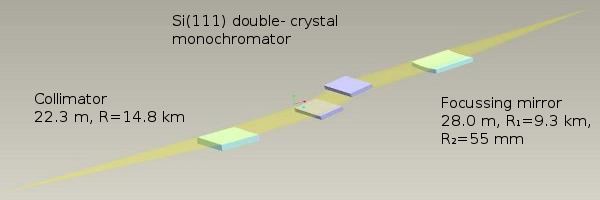X-rays are an invaluable probe of the structure of matter, and the range of problems where X-rays have proved to be decisive in unravelling the matter detailed structure and properties is very wide. The X-Ray Diffraction 1 (XRD1) beamline has been designed (in collaboration with the Istituto di Cristallografia - CNR) as a general-purpose hard X-rays beamline and the features of the beamline allow to perform a wide variety of experiments. The light source is a multipole wiggler with a useful range from 4 to 21.5 keV. The optics consist in a vertical collimating mirror, a double-crystal Si(111) monochromator followed by a bendable focussing mirror. The multipole wiggler spectrum includes high photon flux at low energies, allowing the optimization of the anomalous signal of several heavy atoms (up to the calcium edge), and offering the enhancement of the Sulphur anomalous signal. The experimental setup consists in a Huber goniometer with k geometry fully controllable from remote. The beamline allows to make science on small molecules and large proteins via crystallography, run powder diffraction measurements at enviromental and non-standard conditions (high pressure, high and low temperatures). Transmission and grazing incience experiments are run routinely. The beamline is equipped with a Pilatus 2M single-photon counting detector and a sample mounting robot with a capability of 50 samples based on SPINE standard. Robot can opearte both in cryogenic ( for macromolecular crystallography measurements) and standard conditions (for powder diffraction samples stored in capillaries).
NdBFe Multipole Wiggler (Hybrid linear)
Monochromator
Distance from source = 24059 mm
Energy range = 4-21 keV
Fine tuning with piezo actuator; feedback from 4-quadrant ion chamber
Radius (calculated) = 14.8 km
Distance from source = 22319 mm
Incidence angle = 3 mrad
Tangential radius = 9.31 km
Sagittal radius = 55.27 mm
Distance from source = 28018 mm
Incidence angle = 3 mrad
Experimental Hutch
Sample
Sample Environment
Sample Holders
Dectris Pilatus 2M
Detection
MarCCD165
Detection
- Crystallography
- Crystallography (biological macromolecules)
- Powder diffraction
- Surface diffraction
- X-ray fluorescence (XRF)
- X-ray holography
- Catalysis
- Electrochemistry
- Green Chemistry
- Other - Chemistry
- Physical Chemistry
- Geology
- Mineralogy
- Other - Earth Sciences & Environment
- Other - Energy
- Nanotechnology & production processes
- Other - Engineering & Technology
- Arts
- Cultural Heritage
- Data processing
- Medicine
- Molecular and cellular biology
- Other - Life Sciences & Biotech
- Pharmaceutics (drug screening)
- Protein and macromolecular structures
- Knowledge based multifunctional materials
- Other - Material Sciences
- Technique Development - Material Sciences
- Hard condensed matter - electronic properties
- Hard condensed matter - structures
- Matter under extreme conditions, warm dense matter, plasmas
- Surfaces, interfaces and thin films
- Tango Controls
- images, spectra
- cbf, tiff, mccd, csv
- ccp4, xds, expo, fit2d, shelx, etc.
